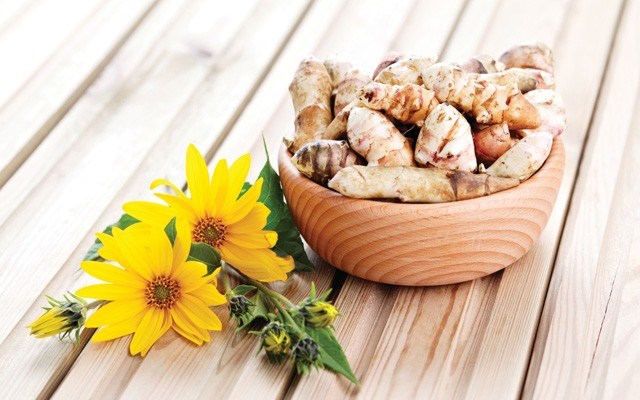The overlooked: It's a popular theme in the art world these days, from re-examining genres like still life paintings with their focus on everyday objects to using overlooked, everyday materials, like wax paper or broken egg shells.
So with warm, sunny days finally delivering a taste of summer, I asked a couple of local farmers, who are super-busy out in their fields right now making the most of their creativity, what their favourite overlooked vegetables are. Veggies we overlook because we don't know how to use them, we take them for granted, or they're simply not on our radar screens in a good way. Besides, this long, cool spring has meant a lot of folks are just getting their plantings in now, so overlooked veggies for the dinner table might also be fun to try in an empty corner or a spare pot.
First off, Jennie Helmer's overlooked picks are White Rose potatoes and mizuna.
Helmer's organic farm in Pemberton has been known for its amazing potatoes for nearly 40 years. So it's doubly appropriate that Jennie's first pick highlights what might be the most taken-for-granted veggie in Canada. According to Statista, Canadians ate 765,000 tonnes of potatoes last year, or about 47 pounds per person, making us more Potatoheads than Cheeseheads.
You might go "ho-hum" when you think "potatoes," but when Jennie describes White Rose potatoes, they're elevated to the divine.
"White Rose are one of the earliest varieties to flower in the fields, and tasting that first tiny spud in early summer is pretty close to heaven," she notes. "They hold their shape when boiled, and are amazing in potato salad, baked and boiled — butter and cracked salt to follow, of course."
White Rose potatoes came out of a trend in the 19th century as producers were looking for new potato varieties that had better flavour and were hardier against pests and diseases. They were first grown in New York in the 1870s.
"In a world with over 5,000 potato varieties to choose from, getting the right potato at the right time can be a real challenge, but not with the White Rose!" Which brings us to another interesting point, one totally overlooked unless you're a farmer.
"It's a difficult process growing multiple potato varieties and the land each separate variety requires to grow is huge. So... that which we choose to grow is a very conscious decision," says Jennie.
As for her second "overlooked" pick, it's mizuna — those lovely leafy greens with serrated edges that remind me of Japanese maple leaves and are often found in salad mixes. Native to Japan, mizuna is a member of the Brassica genus along with veggies like cabbage and broccoli; all of them are part of the mustard family. Enjoy your mizuna raw or cooked. It's slightly peppery flavour holds up either way.
Sorry, you can't get mizuna from Helmers' market stands (it's their own private delight) but you can through Stefan Butler and Nutrient Dense Farm in Brackendale.
As for Stefan, his top pick for an overlooked veggie is something he grows a lot of and something I've never tried because I don't know what the heck to do with them — Jerusalem artichokes. Also known as sunchokes, we eat the tuber or root, but this is actually a species of sunflower. The plants make a beautiful flower some farmers sell. They're similar to but not as big as sunflowers.
"It grows more in the eastern stretch of North America, so it was a key crop for the natives and settlers when they first arrived, because that was where they roughly landed, some of them, and it migrated westward over time," he says.
Gardeners take note: Jerusalem artichokes are extremely easy to grow. Since they're a tuber, you propagate them just like a potato. They prefer fertile soil but will survive just about any conditions and, according to Stefan, you can get a lot of volunteers.
By the time you see them at the farmers' market, Jerusalem artichokes look a lot like ginger — big or quirky-looking ginger — but close enough that a lot of people mistake them for it. As for eating 'chokes, you've got lots of options.
"This is the beauty of the sunchoke — you can use it raw; you can cook it exactly like a potato," he says.
There's no starch in Jerusalem artichokes so they're very creamy in texture. A lot of chefs like to make purees and soups with them. They have a unique nutty sweetness, so you can also dehydrate sunchokes, grind them into powder, and use them as a sweetener in baking. Some of Stefan's diabetic customers swear by them.
You can eat them raw like an apple (don't bother to peel them) or shred them over a salad. Stefan's favourite way to use them is to wash and boil the 'chokes for about four minutes, until a fork pierces them without too much resistance. Then puree them in a food processor with some balsamic vinegar, olive oil, fresh garlic and onion to taste and whatever else you want to make a fabulous, thick dressing to pour over your favourite salad. Bonus: sunchokes are super-healthy for your digestive system.
Find Jerusalem artichokes at Nutrient Dense Farm every Thursday, 2 to 6 p.m., 1524 Depot Rd., just off Highway 99, and at the Mount Pleasant and Kitsilano farmers' markets in Vancouver. It's worth the wait, though, for your White Rose potatoes from Helmer's. They'll be available this summer at the farmers' markets in Pemberton, East Van and Kits.
Glenda Bartosh is an award-winning journalist who can't wait to try Jerusalem artichokes.




